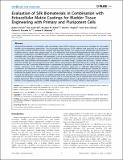| dc.contributor.author | Franck, Debra | |
| dc.contributor.author | Gil, Eun Seok | |
| dc.contributor.author | Adam, Rosalyn Mare | |
| dc.contributor.author | Kaplan, David L. | |
| dc.contributor.author | Chung, Yeun Goo | |
| dc.contributor.author | Estrada, Carlos R. | |
| dc.contributor.author | Mauney, Joshua Robert | |
| dc.date.accessioned | 2013-06-03T16:30:01Z | |
| dc.date.issued | 2013 | |
| dc.identifier.citation | Franck, Debra, Eun Seok Gil, Rosalyn Mare Adam, David L. Kaplan, Yeun Goo Chung, Carlos R. Estrada, and Joshua Robert Mauney. 2013. Evaluation of silk biomaterials in combination with extracellular matrix coatings for bladder tissue engineering with primary and pluripotent cells. PLoS ONE 8(2): e56237. | en_US |
| dc.identifier.issn | 1932-6203 | en_US |
| dc.identifier.uri | http://nrs.harvard.edu/urn-3:HUL.InstRepos:10708043 | |
| dc.description.abstract | Silk-based biomaterials in combination with extracellular matrix (ECM) coatings were assessed as templates for cell-seeded bladder tissue engineering approaches. Two structurally diverse groups of silk scaffolds were produced by a gel spinning process and consisted of either smooth, compact multi-laminates (Group 1) or rough, porous lamellar-like sheets (Group 2). Scaffolds alone or coated with collagen types I or IV or fibronectin were assessed independently for their ability to support attachment, proliferation, and differentiation of primary cell lines including human bladder smooth muscle cells (SMC) and urothelial cells as well as pluripotent cell populations, such as murine embryonic stem cells (ESC) and induced pluripotent stem (iPS) cells. AlamarBlue evaluations revealed that fibronectin-coated Group 2 scaffolds promoted the highest degree of primary SMC and urothelial cell attachment in comparison to uncoated Group 2 controls and all Group 1 scaffold variants. Real time RT-PCR and immunohistochemical (IHC) analyses demonstrated that both fibronectin-coated silk groups were permissive for SMC contractile differentiation as determined by significant upregulation of α-actin and SM22α mRNA and protein expression levels following TGFβ1 stimulation. Prominent expression of epithelial differentiation markers, cytokeratins, was observed in urothelial cells cultured on both control and fibronectin-coated groups following IHC analysis. Evaluation of silk matrices for ESC and iPS cell attachment by alamarBlue showed that fibronectin-coated Group 2 scaffolds promoted the highest levels in comparison to all other scaffold formulations. In addition, real time RT-PCR and IHC analyses showed that fibronectin-coated Group 2 scaffolds facilitated ESC and iPS cell differentiation toward both urothelial and smooth muscle lineages in response to all trans retinoic acid as assessed by induction of uroplakin and contractile gene and protein expression. These results demonstrate that silk scaffolds support primary and pluripotent cell responses pertinent to bladder tissue engineering and that scaffold morphology and fibronectin coatings influence these processes. | en_US |
| dc.language.iso | en_US | en_US |
| dc.publisher | Public Library of Science | en_US |
| dc.relation.isversionof | doi:10.1371/journal.pone.0056237 | en_US |
| dc.relation.hasversion | http://www.ncbi.nlm.nih.gov/pmc/articles/PMC3567020/pdf/ | en_US |
| dash.license | LAA | |
| dc.subject | DNA transcription | en_US |
| dc.subject | agriculture | en_US |
| dc.subject | crops | en_US |
| dc.subject | fibers | en_US |
| dc.subject | silk | en_US |
| dc.subject | biology | en_US |
| dc.subject | biochemistry | en_US |
| dc.subject | cytochemistry | en_US |
| dc.subject | extracellular matrix | en_US |
| dc.subject | biotechnology | en_US |
| dc.subject | tissue engineering | en_US |
| dc.subject | developmental biology | en_US |
| dc.subject | cell differentiation | en_US |
| dc.subject | genetics | en_US |
| dc.subject | gene expression | en_US |
| dc.subject | protein translation | en_US |
| dc.subject | molecular cell biology | en_US |
| dc.subject | cellular types | en_US |
| dc.subject | stem cells | en_US |
| dc.subject | embryonic stem cells | en_US |
| dc.subject | induced pluripotent stem cells | en_US |
| dc.subject | muscle cells | en_US |
| dc.subject | materials science | en_US |
| dc.subject | biomaterials | en_US |
| dc.subject | medicine | en_US |
| dc.subject | urology | en_US |
| dc.subject | ureteric disorders | en_US |
| dc.subject | bladder disorders | en_US |
| dc.title | Evaluation of Silk Biomaterials in Combination with Extracellular Matrix Coatings for Bladder Tissue Engineering with Primary and Pluripotent Cells | en_US |
| dc.type | Journal Article | en_US |
| dc.description.version | Version of Record | en_US |
| dc.relation.journal | PLoS ONE | en_US |
| dash.depositing.author | Adam, Rosalyn Mare | |
| dc.date.available | 2013-06-03T16:30:01Z | |
| dc.identifier.doi | 10.1371/journal.pone.0056237 | * |
| dash.contributor.affiliated | Adam, Rosalyn | |
| dash.contributor.affiliated | Mauney, Joshua | |
| dash.contributor.affiliated | Estrada, Carlos | |
| dash.contributor.affiliated | Chung, Yeun Goo | |


